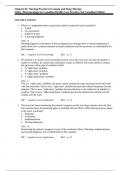Exam (elaborations)
Chapter 01: Nursing Practice in Canada and Drug Therapy Lilley: Pharmacology for Canadian Health Care Practice, 3rd Canadian Edition
- Course
- Testsbanks
- Institution
- Testsbanks
Chapter 01: Nursing Practice in Canada and Drug Therapy Lilley: Pharmacology for Canadian Health Care Practice, 3rd Canadian Edition
[Show more]



